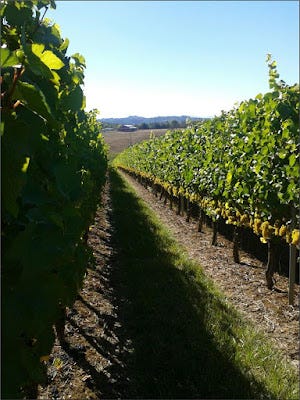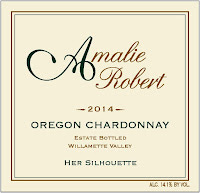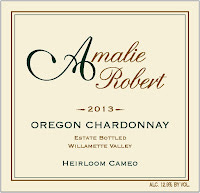Amalie Robert Estate: An Update on the Chardonnay Program
An Update on the Chardonnay Program
at Amalie Robert Estate
Spring 2016
It all started out innocently enough. At the turn of the century we had just acquired the last best place on Earth to grow exotically expressive Pinot Noir and thought that if we planted Pinot Meunier and Chardonnay, we could make sparkling wine. Ah, to be young again…

Aka: What was I thinking?
So it was, we passed on the rest of the planets and chose the sedimentary soils of Oregon’s Northern Willamette Valley. That first year we planted 2 clones of Chardonnay and some Pinot Meunier along with several clones of Pinot Noir. The final tally was about 15,000 vines, posts and wire “all in.” Add three years of on-site, hands-on, high-intensity, on-the-job viticulture “home schooling” and we had managed to ripen a wee little bit of Chardonnay.
They say you always remember your first, and our first harvest was 2002. At dawn we approached block 24 from the south with high hopes, new buckets and clippers at the ready. It seems like just yesterday. We began harvesting at the bottom of the rows and worked our way to the top. The birds began harvesting in the middle of the rows and they always kept just a few vines ahead of us. For the first few years, most of our Chardonnay production was sold.
Our Estate grown Chardonnay is comprised of 2 Dijon Clones – 76 & 95, both grafted onto a deep rooted, vintage extending rootstock called 5C. This rootstock takes a bit longer to build sugars, which allows for longer hang-time to develop stunning aromas and flavors. Growing wine on 5C clearly represents the road less travelled with most growers choosing earlier to ripen rootstocks. But 5C has proven itself worthy especially in these recent warm vintages where we can hang longer into the vintage to develop aromas and flavors without excessive sugar accumulation.

Once Ernie decides he has all of the aroma and flavor he is going to get from the vintage, he pulls the trigger on harvest. Bucket after bucket of hand harvested, golden hued berries are loaded into harvest bins for a very short ride to the winery where the press is eagerly awaiting them.

Our Chardonnay is always whole cluster pressed as they do in Champagne. The reason behind this is that we are “acid enthusiasts.” By NOTcrushing the berries before going into the press, we are able to extract wildly expressive Chardonnay character without releasing the potassium bound to the inside of the skins. It is potassium that raises our pH and reduces the perception of acidity. Our whole cluster press method allows for pure aroma and flavor punctuated with crisp acidity. While it is the case that we get less juice than those who crush, we feel it is better juice.
The pressed juice settles overnight and the next day we move the juice by gravity to ferment. In the early years, we just used 1,000 liter stainless steel tanks. As we became more comfortable with our aroma and flavor profiles and the style of wine we wanted to create, we chose a 500 liter puncheon for our Heirloom Cameo barrel fermented chardonnay (BFC.)
Note: Puncheon is just a code word for a 500 liter barrel. They can also be coopered into 400 and 600 liters. While we don’t use them, a feuillette is a half barrel with a capacity of 114 liters. Good to know!
Our Chardonnay fermentations usually last about 2 to 3 weeks, but in some cases can last 2 or 3 months – Oh joy… A secondary or malolactic conversion will convert the malic acid (think Granny Smith green apple acid) into a softer lactic acid. Stylistically, we block this conversion in our stainless steel fermented Chardonnay, Her Silhouette. The Heirloom Cameo BFC may see partial, full or no conversion whatsoever depending on the vintage - Aka Mother Nature’s mood.
The fermentation space in our multi-level, gravity flow winery is not heated and that is where Her Silhouette spends the winter months. As the temperature drops, all of the little “wine diamonds” form on the sides and bottom of the tank. After a few weeks of this cold stabilization we rack the wine from the tanks and are ready to bottle a new vintage of clean and crisp Her Silhouette Chardonnay. We keep the wine diamonds here at the winery and out of your glass.
The Heirloom Cameo BFC takes a different route to the bottling line. Once the primary fermentation finishes in barrel, we may inoculate with bacteria to perform the malolactic conversion. These little bacteria are quite finicky and will only convert malic acid to lactic acid if the alcohol, acidity and temperature are just right. The art of winemaking meets the precision of science.
Either way, with or without the malolactic conversion, the wine remains in the new 500 liter puncheon for about 14 months. During this time the pure aromas and flavors of Chardonnay are intertwining with the mildly toasted, tight grained French oak. And around the 12 month mark another little bit of magic is revealed. The yeast that fermented the whole cluster pressed juice begin to break down, it was just a matter of time. For the next couple of months, the wine gains a bit of richness and a little weight, or what we like to call “palate presence.” Remove the wine from barrel too soon and you miss this significant nuance in the wine.
And speaking of the barrel, why do we use a 500 liter puncheon instead of a regular sized 228 liter Burgundy barrel? The reason is we are using the barrel to add some texture without overpowering the wine with excessive wood tannins or oak sweetness. It’s really all about surface to volume ratios. Consider the pepperoni to crust ratio in the personal sized pizza to the extra large pizza. We have significantly more wine to absorb the new oak influence with a 500 liter puncheon. We also save out the butter for the popcorn.
Add 14 months of puncheon barrel age to the mix and we are ready for a trip to the fermentation floor for a few weeks of cold stabilization. The Heirloom Cameo from the prior harvest and the Her Silhouette from the current harvest sit side by side in identical tanks. It falls under the “science” part of winemaking to appropriately and legibly mark each tank.
Now, not many people know this about Chardonnay, but it used to be the favorite wine of Swashbucklers, Pirates and other nefarious characters. Before they discovered the Caribbean, and rum, you could hear them yell out for a flagon of CHAAAAAAAAAARDONNAY!!

We grow all of our wine including Chardonnay at Amalie Robert Estate under the watchful eye, and sometimes excessive rains, of Mother Nature. Our wines are Estate Bottled which means we have had complete control over our entire process onsite from growing the fruit, to fermenting the wine through to blending and bottling. We are also the bottling team, so you can rest assured that we have seen the process through from beginning to end (and there is a free cork in every bottle!)

Her Silhouette Chardonnay reveals Estate grown Chardonnay in its purest form. We strive to capture the pure, unadulterated essence of Chardonnay harvested at first light.
Her Silhouette is fermented in stainless steel at cool temperatures to showcase the aromatic profile of Chardonnay. We block the malolactic conversion to preserve Chardonnay’s natural acidity providing a disciplined finish.
The combination of Estate grown Dijon Clone fruit from sedimentary soils, stewarded through fermentation with very little winemaking intervention results in unrelenting aromas with an intensely flavored palate experience punctuated with trenchant acidity. This is intentioned Oregon Chardonnay that exemplifies the true character of the vineyard, vintage and the variety. Case production varies between 100 – 200 cases.
2013 Her Silhouette
- Wine Enthusiast, April 2016 - 92 points, Editors’ Choice
2012 Her Silhouette
Lifted and light, this stainless-steel-fermented chardonnay reads almost like an Alsace wine, its heady apple scents lifted with peach notes. The flavors are invigorating and tense, the pear-like juiciness framed by a phenolic grip. Chill it down for clam pasta.
- Wine & Spirits Magazine, December 2015 – 91 points, Best Buy
An interesting comparison to the previous vintage, this wine has a point and a half more alcohol, with a rich, substantial mouthfeel. Ripe citrus fruit, light tropical fruit and full, open flavors are found on the palate. Drink this while in its youth, and let the previous vintage age another couple of years.
- Wine Enthusiast, June 2015 – 90 points
2011 Her Silhouette
If your tastes run to fruit-driven, all-stainless, crisp and steely Chardonnays, this is a great choice. Bright pineapple and citrus fruit flavors abound, and the acids, though substantial, are juicy and natural. The balance, freshness and overall value put this among best of class.
- Wine Enthusiast, June 2015 – 90 points, Editors’ Choice
2009 Her Silhouette
Tart and slender, this is deceptive at first it seems a little thin, but as it opens in the glass into a succulent, well-defined, racy wine with citrus and peach, mineral and herb. It's not delicate, but its muscularity is concealed behind elegant styling.
- Wine Enthusiast, March 2011– 90 points, Editors’ Choice

Heirloom Cameo Chardonnayis our BFC. Or as Dena would explain it: “This wine wraps you in an elegant silk scarf and instantly makes you feel really good - about being you.” It’s our answer to Montrachet, be it Chassagne or Puligny.
The Heirlom Cameo is fermented in a single, new, large format French oak barrel or “puncheon” each year. The goal of this fermentation style is to enhance the breadth and depth of the wine through limited oak exposure and extended yeast or “lees” aging.
Stylistically, this wine is made to be enjoyed throughout its time in bottle. Upon release the wine is fresh with pungent aromas and a broad mouth feel, followed by a crisp and satisfying finish. We expect this wine to age gracefully for several years and will reward a laddered approach to monitoring its development. Production is limited to 70 cases.
2012 Heirloom Cameo
This barrel-fermented, estate-grown wine matches its luscious citrus and pineapple fruit to veins of butter, caramel and toast. It’s perfectly balanced, lively and fresh, even after being open for a full 24 hours. The style, now becoming particular to many Oregon Chardonnays, sits squarely on the fence between the hyper-lushness of Californiaand the minerality of northern Burgundies.
- Wine Enthusiast, June 2015 - 92 points
The 2012 Chardonnay Heirloom Cameo is whole-cluster pressed and fermented in 500-liter puncheons and underwent partial malo before maturation in barrel without lees-stirring for 14 months. It has an attractive bouquet with citrus lemon, candied orange peel and yellow flowers that is nicely defined and neatly integrated the oak. The palate is medium-bodied with quite a rich and generous entry, waxy in texture with touches of toffee apple and shaved almond on the finish. This is a very well-crafted Chardonnay packed full of flavor. Only 70 cases produced.
- Wine Advocate, March 2015 - 90 points
2011 Heirloom Cameo
The 2011 Chardonnay Heirloom Cameo is the second vintage released, whole-cluster pressed and fermented in a 500-liter puncheon with batonnage. Unlike the 1012, this went through full malolactic. It has a paler color than the 2012, but perhaps greater delineation and precision on the nose with citrus peel, honeysuckle and juniper berries. The palate is well defined with crisp acidity, touches of almond and toffee apple, the leesy element coming through subtly on the persistent finish. Low key now, but I bet you this ages with a little more panache than the more outgoing 2012. We’ll see!
- Wine Advocate, March 2015 - 91 points
2009 Heirloom Cameo
A flinty scent of seashells enlivens golden delicious apple aromas in this lean, bequiling white. It has a voluptuous texture, with juicy pear flavors supported by a clean mineral line. That mineral foundation focuses it through long finish. For roast cod.
- Wine & Spirits, October 2011 – 93 points, Year’s Best Chardonnay article
Lush and toasty, this barrel-fermented Chardonnay offers an explosion of semi-tropical fruits that coat the tongue without tiring the palate. Almost Rhône-like—it could pass for a Roussanne in a blind tasting—it’s exotic and complex.
- Wine Enthusiast, December 2011 - 92 points
Light straw color and clear in the glass. Enticing aromas of white peaches, lemon curd, white pears and buttery oak. Delicious and juicy array of white peach, Asian pear, baked apple and pineapple flavors, honed with just the right amount of mineral-driven acidity for brightness, and offering a silky mouth feel that excites the senses. A classic, and maybe the best Oregon Chardonnay I have ever had. Exceptional rating.
- PinotFile, November 2011, Exceptional rating
The Heirloom Cameo may be the best New World Chardonnay I have ever tasted!
- Dennis Sienko – Bend Wine Cellar, May 2011

A “Once in a Lifetime” Wine.
Pabuk’s Gift is our Late Harvest Botrytized Chardonnay, a gift from Typhoon Pabuk which gifted us 9 inches of rain in 4 days just before harvest. This wine was made from individually hand sorted Chardonnay grapes naturally conquered by Botrytis in the same manner as a German Trockenbeerenauslese (dried berries selection.) This wine may also be applied topically and removed orally. Production is 52 cases (375 ml.)

2013 Pabuk’s Gift Late Harvest Chardonnay
“Sometimes disasters have a happy ending. Such is this wine, one of the GREATEST LATE-HARVEST WINES ever created in the Pacific Northwest: the 2013 Amalie Robert Estate Botrytis Chardonnay.
In 2013, everything was hunky dory in Oregonvineyards. The beautiful vintage was right on schedule until the massive remnants of Typhoon Pabuk dumped 9 inches of rain on western Oregon over four September days. After that sogfest, the weather dried out and Amalie Robert winemaker Ernie Pink, a bit dejected, walked his vineyards, discovering that the Noble Rot, Botrytis cinerea, had infected his Chardonnay.
He and his wife, Dena Drews, managed to salvage a mere 70 buckets of shriveled and affected grapes in late October. It took them 3 days of hand picking the good mold from the bad --berry by berry-- to get the juice for this extraordinary wine. The nectar measured 44% sugar, and the wine fermented to 10% alcohol. The resulting wine is easily mistaken for a top-tier French Sauternes.
This honeyed gift is a fantastic achievement and probably a once-in-a-lifetime wine. Or so they hope! And, it is, to the best of my knowledge, the first late-harvest botrytis Chardonnay ever produced in Oregon. If anyone knows differently, Dena, Ernie, and I would sure love to know.”
- Ron Zimmerman, February 2015 - The Herbfarm, AAA 5-Diamond, Seattle, WA
The 2013 Pabuk’s Gift is the result of the namesake typhoon after it wiped out the Chardonnay vines. There were 70 buckets of berries that were pressed over a day, then fermented up to 10.2% alcohol and stopped with dry ice. The bouquet is clean and pure with clear honey, quince jus, marmalade and just a touch of wax resin. The palate is medium-bodied with racy acidity cutting through the mellifluous honeyed fruit and it works because it is not overpowering or cloying on the finish, but glides across the mouth. Perhaps it should be renamed Pabuk’s silver lining?
- Wine Advocate, March 2015 - 91 points




